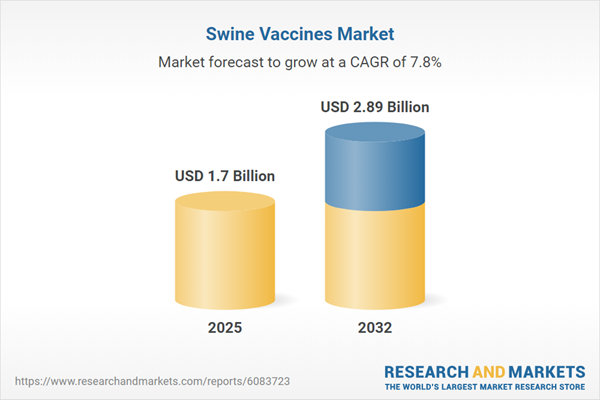Speak directly to the analyst to clarify any post sales queries you may have.
The swine vaccines market is experiencing significant evolution as next-generation vaccine technologies and shifting disease patterns drive new priorities for producers, regulators, and suppliers. Senior decision-makers need reliable analysis on the trends shaping herd health, innovation pipelines, and the fast-changing risk landscape across global supply chains.
Market Snapshot: Swine Vaccines Market Overview
The swine vaccines market grew from USD 1.58 billion in 2024 to USD 1.70 billion in 2025. Steadily advancing at a CAGR of 7.83%, the market is forecast to reach USD 2.89 billion by 2032. Key drivers include rising pork demand, evolving disease threats, and strategic industry responses across regions. Companies are leveraging collaborative initiatives, biotechnological advances, and digital solutions to improve vaccine precision, expedite approvals, and address new regulatory and trade dynamics.
Scope & Segmentation
- Vaccine Types: DNA, inactivated, live attenuated, recombinant, subunit, and toxoid vaccines.
- Animal Ages: Breeders (boars and sows), finishers, growers, piglets, and weaners.
- Administration Routes: Injection, nasal, and oral formulations.
- Packaging Formats: Multi-dose bottles, pre-filled syringes, vials.
- End User Groups: Commercial farms, research institutes, veterinary clinics, veterinary hospitals.
- Disease Targets: Classical swine fever, erysipelas, Mycoplasma pneumonia, porcine circovirus, porcine reproductive and respiratory syndrome, swine influenza.
- Distribution Channels: Online pharmacies (including company websites and e-commerce platforms), veterinary clinics, and hospitals.
- Geographies Covered: Americas (United States, Canada, Mexico, Brazil, Argentina, Chile, Colombia, Peru), EMEA (United Kingdom, Germany, France, Russia, Italy, Spain, Netherlands, Sweden, Poland, Switzerland, United Arab Emirates, Saudi Arabia, Qatar, Turkey, Israel, South Africa, Nigeria, Egypt, Kenya), and Asia-Pacific (China, India, Japan, Australia, South Korea, Indonesia, Thailand, Malaysia, Singapore, Taiwan).
- Company Profiles: Zoetis Inc., Merck & Co., Inc., Boehringer Ingelheim Animal Health GmbH, Elanco Animal Health Incorporated, Ceva Santé Animale SAS, Virbac S.A., Vetoquinol S.A., HIPRA, S.A., Phibro Animal Health Corporation, IDT Biologika GmbH.
Key Takeaways for Senior Decision-Makers
- Advanced immunology and biotechnology tools are pushing swine vaccine development toward tailored, precision-targeted platforms addressing current and emerging pathogens.
- Regulatory shifts are encouraging faster product approvals and incentivizing cross-sector collaborations between animal health companies and biotech innovators.
- Digital health solutions, including remote monitoring and real-time analytics, are becoming essential for optimizing vaccine programs, especially in high-volume or biosecure production environments.
- Tariff changes, as seen in recent US policy adjustments, are creating new pressures on raw material sourcing and production localization, affecting cost structures and supply chain decisions.
- Regional market dynamics vary significantly; for example, Asia-Pacific’s local manufacturing efforts and digital outreach help mitigate supply chain risks unique to that geography.
- Competitive strategies are focused on R&D diversification, mergers, and partnerships, enabling faster response to disease evolution and market shifts.
Tariff Impact: Responding to Shifting Trade Policy
- Recent United States tariffs have increased costs for vaccine manufacturers relying on international suppliers, leading many to reconsider their supply chain models.
- Manufacturers are responding by investing in domestic production facilities, establishing co-manufacturing alliances, or seeking tariff-exempt arrangements to buffer cost volatility.
- Strategic inventory management and supplier diversification, as well as exploring multi-currency invoicing, are now critical risk mitigation practices for the industry.
Methodology & Data Sources
This report employs a transparent research process combining primary interviews with veterinary experts, production managers, and regulatory officials, alongside secondary data from scientific publications, corporate disclosures, and regulatory filings. Analytical rigor is ensured through triangulation and peer review protocols.
Why This Report Matters
- Enables evidence-based planning by providing granular segmentation and actionable strategic insights for research, operations, and business development teams.
- Highlights emerging trends from technological innovation, regulatory reform, and market access dynamics to inform risk management and growth strategies.
- Delivers a region-specific perspective on opportunities and challenges, supporting effective resource allocation across diverse global contexts.
Conclusion
The swine vaccines market is entering a period of dynamic change as scientific, regulatory, and operational factors intersect. Adaptive strategies and robust supply chains will be essential to realize long-term value and resilience in this growing field.
Table of Contents
3. Executive Summary
4. Market Overview
7. Cumulative Impact of Artificial Intelligence 2025
Companies Mentioned
The companies profiled in this Swine Vaccines market report include:- Zoetis Inc.
- Merck & Co., Inc.
- Boehringer Ingelheim Animal Health GmbH
- Elanco Animal Health Incorporated
- Ceva Santé Animale SAS
- Virbac S.A.
- Vetoquinol S.A.
- HIPRA, S.A.
- Phibro Animal Health Corporation
- IDT Biologika GmbH
Table Information
| Report Attribute | Details |
|---|---|
| No. of Pages | 183 |
| Published | October 2025 |
| Forecast Period | 2025 - 2032 |
| Estimated Market Value ( USD | $ 1.7 Billion |
| Forecasted Market Value ( USD | $ 2.89 Billion |
| Compound Annual Growth Rate | 7.8% |
| Regions Covered | Global |
| No. of Companies Mentioned | 11 |









